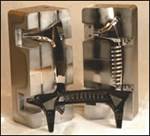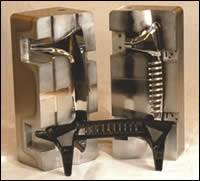Reducing or Maintaining Cycle Times with Mold Coating
No matter the size of a tool, taking into consideration your GPM within your tooling’s cooling systems and using electroless nickel coating is an effective way to improve or maintain desired cycle times.
Challenge: Request for electroless nickel coating services on a mold’s cooling lines.
It’s a known fact that mold cooling has a direct bearing on mold productivity; and, therefore optimizing the gallons per minute (GPM) that flow through your cooling system, and the thermal conductivity of the mold material is the best way to optimize productivity. Of course, other factors come into play, such as placement and size of water lines, temperature control, and the wall thickness of the materials being molded. But when it all comes down to it, once those parameters are set the only factor left that can be controlled is the GPM.
Is plating the insides of cooling lines a common practice? There is often heavy corrosion on tooling—including the water lines—causing thermal conductivity to be greatly reduced and pushing cycle times up. The quality of parts also can be compromised. Many molders don’t pay as much attention as they should to their cooling lines and maintaining the proper temperature of their mold and GPM. But they should. It’s important—just like any other part of a proper preventive maintenance plan.
Corrosion Protection of Water Lines with Electroless Nickel
Many mold shops request the corrosion protection of electroless nickel. For example, a beryllium core cap sits on the steel core and where there is contact you have to worry about a galvanic reaction between these dissimilar metals due to corrosion. An application of electroless nickel is generally recommended, which will provide a layer of protection between the beryllium and the steel to prevent, or insulate, against that galvanic reaction.
The same benefits can be derived by using it on the water lines, and this was the reason mold manufacturer, Strohwig Industries (Richfield, WI) sought out an engineered coatings and finishes provider with expertise in electroless nickel coatings. They understand the connection between the use of electroless nickel and optimizing cooling for the life of the mold because they have utilized this strategy previously.
“We’ve done it many times on molds. In the big picture, it is a very small investment for a mold that will run for years to come,” comments Jeff Boutin, project manager at Strohwig. “It keeps performance on track. But we’ve never tried it with a mold of this size before.”
This particular mold weighs in excess of 100,000 pounds. Strohwig built the tool
for an important customer and wanted to ensure that the cycle time was main-tained over the life of the tool. So they decided to nickel plate the water lines.
“When somebody spends that much money on a tool and the water lines corrode, they will eventually start losing their cycle,” Boutin adds. “We built this tool so that it is an internally balanced system. We expect to be running about 200 GPM through each half. When you get calcium build-ups and rust in the water lines you lose cycle time, and the cooling becomes unbalanced. What can we do to help eliminate that? Nickel plate the water lines.”
Challenge: In-House Water Line Coating Treatment on Large Tool
Needless to say, with a tool this large, the service was outsourced and performed in-house by an engineered coatings and finishes provider, such as Bales. Actually, because of the time needed just to prepare a tool for this kind of coating treatment, two house calls were required—one for each half.
But before heading to the Strohwig plant, all of the geometry was calculated to ensure that the proper thickness of coating to the cooling lines was applied. Every step had to be engineered ahead of time and the right tools and precise calculations had to be in place. Finally, an electroless nickel tank, among other tools, was brought to the Strohwig plant and prep began on the tool.
The first step is cleaning the lines with a soapy solution, and then doing an acid rinse that will help activate the surface inside the cooling lines and make it ready for the electroless nickel chemistry. Then it was time to heat the tool to just the right plating temperature.
It took about three days just to raise the temperature of the core half of this large tool to 190oF; and five days for the cavity half. It required the use of a 12,000-watt heater.
Once the temperature was reached, the plating process began. But it wasn’t as simple as just letting the electroless nickel chemistry run through the cooling lines. There are many other factors that come into play, not the least of which is the flow rate of the chemistry.
Just like the GPM of water through the lines affects cooling and cycle times, so does the success of the plating process depend on how fast the electroless nickel is running through the lines. One must maintain the flow rate. Electroless nickel stops plating when the flow across the surface exceeds 7 feet/minute of circulation. It was another calculation that had to be done prior to plating or the whole operation would be compromised.
After several days of performing this very precise plating process, a test of the cooling lines revealed a successful application of the right thickness of the electroless nickel. Strohwig did the right thing in calling for the service once the tool was built because waiting until the lines become corroded only makes the plating process that much more difficult and costly.
Summary
To tell the truth, no matter what cooling lines are plated with, if those lines aren’t properly maintained they could become corroded very quickly. One should always know the pH of the water circulating within a mold. It should be neutral or slightly alkaline to prevent corrosion. There are companies that will come out to analyze the water and they also offer additives that will help maintain the proper ph levels. Enlisting their services can be very helpful.
No matter the size of a tool, taking into consideration your GPM within your tooling’s cooling systems and using preventive measures, such as electroless nickel coating, is an effective way to improve or maintain desired cycle times. As Boutin puts it, “It’s a huge step in terms of maintaining cycle time.”
Related Content
Breaking Down 3D Scanning in Moldmaking
Identifying 3D scanning requirements and implementing the appropriate technology.
Read MoreUnderstanding Manifold Thermal Expansion
Molders, mold builders and repair technicians must fully understand thermal expansion to ensure they don’t damage critical seals during manifold repairs or routine cleanings.
Read MoreLine Width vs. Depth Ratio in Laser Engraving
A laser does not produce 90-degree sidewalls. It requires a certain amount of draft in order to produce the required pattern.
Read MoreHow to Overcome Complex Mold Texturing Problems
Key benefits when considering laser technology for mold texturing and repair.
Read MoreRead Next
How Surface Treatments Keep Molds Operating Longer
Important tips and information about mold coatings to help you achieve the level of production that you and your customers desire.
Read MoreCoatings and Finishes for Electrical and Electronics Molding
Electrical and electronic components take many forms and functions and require special attention when considering surface treatment options.
Read More


















